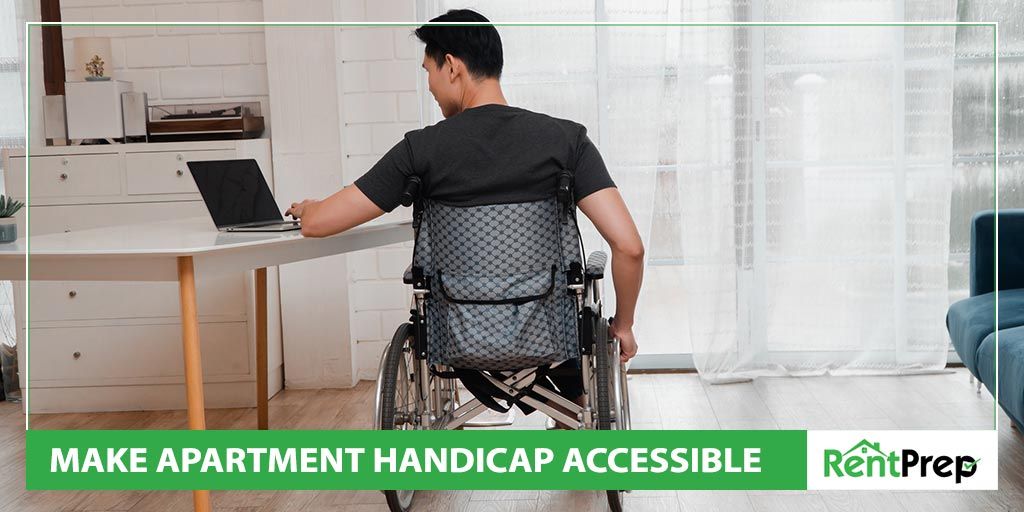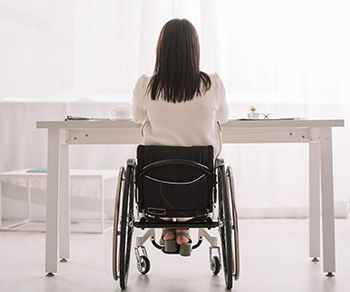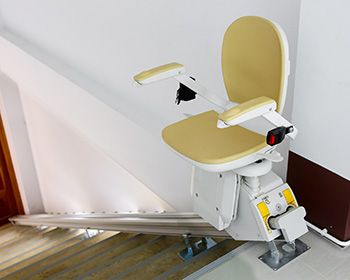
Millions of people in the United States have disabilities. Often, these individuals find that traditional housing options don’t meet their needs. Landlords can attract these potential tenants by taking time to make an apartment handicap accessible so that these rental properties are more comfortable, welcoming, and friendly to those with special needs.
To get a glimpse at what we have to say about handicap-accessible considerations, listen to our podcast episode #197.
Wheelchair-accessible and handicap-accessible apartments are not very common; therefore, disabled or elderly tenants are an underserved market. With a few modifications and changes, you could attract these potential tenants and keep your rental property from sitting vacant.
A Table Of Contents About Handicap Apartments
Handicap-accessible apartments are not nearly as common as they should be. While more landlords take on the task of creating this type of rental property each year, there is still a long way to go before the handicapped tenant market is fully served. Still, there are some important things that you can and should learn about handicapped apartments right now:
- What Is A Handicap Apartment?
- 10 Ways To Convert To Handicap Apartments
- Should You Add Accessible Apartments?
- FAQs On Handicap-Accessible Apartments
- What does a handicap-accessible apartment mean?
- How can I make my apartment more accessible?
- How do I make my bathroom handicap accessible?
- What is different in an ADA apartment?
- Do apartments have to be handicap accessible?
- Can any resident without a handicap modify their apartment?
- Can a landlord refuse to rent to a disabled person?
- Consider Adding Accessibility
What Is A Handicap Apartment?

Modifying an apartment to be accessible for elderly or disabled residents simply means making some changes to accommodate someone who uses a wheelchair, scooter, or walker, or to make living there easier for someone who has limited mobility. Everything from doorways to countertops can pose an obstacle for someone in a wheelchair, for example.
Converting an apartment to accommodate the prospective tenant with physical limitations makes it more accessible and therefore boosts their quality of life. Handicap apartments are often hard to find, so many disabled and elderly residents cannot find what they need.
Apartments that are handicap accessible are not always fully ADA-compliant, and that’s okay if you don’t have a legal obligation to meet ADA standards. Simply having apartments that are accessible in the ways necessary for a disabled tenant is a big step that many landlords don’t take, and it might be worth cornering this market in your area.
Not only will you be providing a resource that can be hard to find for those who have a disability or physical impairment, but you will also be setting yourself up to fill vacancies more efficiently in many cases.
10 Ways To Convert To Handicap Apartments
You can make some basic changes to an existing apartment that would turn it into a handicapped apartment and, therefore, more friendly toward the elderly or the disabled. Other approaches to converting traditional units to handicap apartments require more extensive remodeling.
Here’s a list of 10 ways to modify an existing apartment to cater to those with physical limitations. These are far from the only options for starting renovations, but they’re a great structure to begin with when figuring out how to make an apartment handicap accessible.
By working these ten tips into your rental planning, you’ll begin to create a living atmosphere that will work for those with physical handicaps. As time goes on, you can learn what other adjustments might be useful for attracting specific types of tenants.
#1: Make The Entrance Accessible
Entrances to the apartment should not have stairs but be replaced or covered with a wheelchair ramp. This can be made of wood, aluminum, or even poured concrete. Check your local building codes for ramp angles and other important specifications to ensure you are compliant with the requirements in your area.
#2: Widen Doorways
Doorways must be wide enough to accommodate a standard wheelchair.
From the entrance to the interior doors, this width needs to be at least 32 inches. Consider changing the hinge system on the doors to the swing-away style, allowing doors to open even wider to enable the chair to pass all the way through without hitting it.
#3: Flatten Thresholds
Thresholds must be flat, not raised, to give residents with scooters, wheelchairs, and walkers a smooth path throughout the apartment. Though it might not seem like much to you, a ½-inch threshold can become a big deal to a disabled tenant who doesn’t have much mobility.
#4: Simplify Faucets
Faucets in an accessible apartment should be changed out to single lever style. These are easier for people to grip and maneuver if they don’t have full mobility in their hands, arms, or upper body. Single-lever faucets are simply raised up to turn on, pushed down to turn off, and moved right or left to control temperature.
#5: Ensure Sinks Are Accessible
Sinks are hard for people to access when they are in a wheelchair because low vanity cabinets prevent the user from getting close enough to use the sink effectively. Consider installing pedestal sinks, wall-mounted sinks, or removing the cabinets altogether.
#6: Set Up A Safe Toilet Area
Moving from a wheelchair or scooter to the toilet is a challenge, but an accessible apartment should have a raised toilet in the bathroom. Installing sturdy hand bars by the toilet is another way to ensure that a disabled resident can safely and securely maneuver around when they need to use the toilet.
#7 Add Handicapped-Accessible Bathing
Bathing and showering can be a real challenge for residents who are wheelchair users or cannot lower themselves into a tub or stand for long periods in a shower. It helps greatly when landlords install a handicapped-accessible tub/shower unit.
This is a tall, deep tub with a door on the side that opens to reveal a seat inside. The tenant can sit on the seat and either bathe or shower. The tenant has no high tub wall to climb over, and no slippery shower floor to worry about. These specialized units can easily be installed into existing tub/shower units.
#8: Consider Lowered Countertops
Standard kitchen and bathroom countertops are often too high for someone in a wheelchair or scooter—usually 36 inches for standard height.
Lowering countertops to 30 inches makes all the difference and lets a disabled person reach all the way back, utilizing more of the surface space. In turn, this helps tenants to feel more comfortable and independent in their own homes.
#9: Limit Floor Cabinetry
Floor-level cabinets in the kitchen can hinder the maneuverability of a resident in a wheelchair, so take out some of the floor cabinets, leaving empty space to allow them to get up close to the countertops.
#10: Install A Personal Alarm System
Many landlords who cater to elderly or disabled tenants install a personal alarm system inside the apartment. This is an electronic device that the resident carries around and can activate to summon help if they are sick, hurt, or injured and cannot reach the phone. Some alarms simply make a loud sound, while others are linked to a medical services call center. Providing this as part of an accessible apartment will make it even more attractive to prospective tenants who are elderly or disabled.
Should You Add Accessible Apartments?

Even if you are not legally required to have any handicapped-accessible apartments among your units, it might be something that you want to consider doing anyway. Many individuals with disabilities have shared that finding appropriate units for their needs can be very difficult, which often leads them to be at higher risk of homelessness.
This means that by creating these units, you’ll be helping to solve a problem that affects your community and is often under-addressed. Of course, this isn’t a problem you’re going to solve on your own. Plus, you have your own business to think about as well.
Thankfully, doing good for this underserved part of your community can also be good for your business. Renting out accessible apartments is often easier than renting out other units. Even if there aren’t any disabled individuals seeking apartments in your location, elderly individuals often seek out similar units to keep them safe into the future as they age.
Don’t Forget About Screening
As you work to fill any accessible units you create, remember that you still want to make sure you are thoroughly screening your prospective tenants. You must still collect rental applications, ensure they are completely filled out, and then review the information you receive on the application.
While you should never deny an individual for having a disability, you should still be reviewing their financial and rental history to ensure they will be a good tenant for you.
If you’re having trouble setting up the right screening criteria for your units, consider investing in a high-quality tenant screening service like the screening profiles optioned here at RentPrep. Each of our packages can simplify the process to make screening more efficient and effective than ever before.
FAQs On Handicap-Accessible Apartments
What does a handicap-accessible apartment mean?
The phrase handicap-accessible apartment is used to refer to apartments that have been modified in a way that makes it easier for those with physical limitations to live there. For example, tenants who use a wheelchair would prefer a handicap-accessible apartment to easily maneuver around their unit and live as independently as possible.
How can I make my apartment more accessible?
In today’s guide, we’ve covered 10 ways to make your apartment units more accessible for those with disabilities or physical impairments that may make normal apartment living difficult. In addition to the solutions we have already shared, there are many other things you can do to ensure that your apartment is more accessible.
For example, you might want to create some apartment units that are more accessible for those with hearing or visual impairments. People often think of wheelchairs when considering disabilities, but many also suffer from hearing and vision issues.
For those with visual impairments, improvements such as better lighting, improved sightlines, and alarms that have audio feedback can be incredibly helpful. Individuals who are hard-of-hearing can benefit from alarms, phones, and doorbells with some type of visual notification that will be harder for them to miss.
Consult with local organizations and individuals who serve these communities, to get the best idea of what is necessary to make an apartment truly accessible. These individuals will be most suited to advise you, and they can also help you to advertise your newly complaint apartments in the right places.
How do I make my bathroom handicap accessible?
Bathrooms can be one of the most difficult parts of a rental unit to make more accessible for those with physical handicaps or disabilities. Wheelchair, scooter, and walker users often find it difficult to fit into these spaces, and even harder to use the toilet and shower safely.
The key to these spaces is to work through the following steps:
- Remove all physical barriers, such as cabinets that block the path, doors that aren’t wide enough, vanities that block wheelchairs from going under the sink, etc.
- Ensure there is enough space for a wheelchair user to turn around their chair if necessary.
- Install a raised toilet, and set up secure hand bars that can be used by tenants to safely lift themselves up onto the toilet.
- Install a handicap-accessible shower/bath unit, which includes a door to get into the tub, to prevent slipping and enable tenants to bathe safely.
- Lower the light switches and fan control to be more accessible.
These are just the basics, of course. Additional things you might want to do will include lowering shelving, adding simplified faucets, and potentially even an alarm system. Consult with leading guidance on accessible units to find out what else can be done if you want to go above and beyond in your renovations.
What is different in an ADA apartment?
In an ADA apartment, the unit is set up to be completely safe and accessible for those with physical disabilities, including but not limited to:
- Using a wheelchair or walker
- Having hearing impairments
- Having limited vision
This means that the apartment will typically have specialized flooring, cabinetry, bathroom fixtures, lighting, doorways, and ramps to ensure that a tenant would be able to easily move around without being in danger. Even things like light switches might be installed in nonstandard locations.
The specifics of how an ADA apartment is set up can vary, but basic standards such as door width, counter height, and ramp angle must be followed when setting things up. To learn more about the specifics that are required to be officially registered as ADA-compliant, you can read the full building specifications here. This page also goes through many common questions asked by builders and landlords; you might be able to find the answers to your specific questions there.
Do apartments have to be handicap accessible?
Some organizations, such as the ADA, set up specific standards for communal and public spaces so that they are accessible for all individuals. However, these standards are not equally applied to the actual dwelling, and it is usually up to a landlord to decide if they want to become compliant or not.
In government-subsidized buildings, it is required for there to be a specific percentage of fully accessible apartments, but this is not applied to older buildings due to limitations caused by the original structure. If you aren’t sure whether or not you are required to update some of your properties in a multi-unit apartment building, visit ada.gov for more information on how to become ADA-approved.
Can any resident without a handicap modify their apartment?
Suppose a resident has a note from a doctor or other professional that states they need to have some accessibility modifications installed to live safely. In that case, it is likely covered under ADA. This means that the tenant must be allowed to modify their apartment.
However, this does not mean you have to keep the apartment that way or cover the cost. Just as a tenant who makes superficial changes must put the unit back to how it was, you could expect tenants making modifications to do the same.
However, it might be in your best interest to keep some of the modifications in place after the tenant leaves, especially if you don’t have any other accessible units. It can be very hard for individuals with handicaps or disabilities to find suitable apartments; having this type of unit can fill a specific niche and bring in more tenants.
Can a landlord refuse to rent to a disabled person?
Landlords cannot refuse to rent to a disabled person based on their disability, unless their disability has caused specific and documented violence that could be a threat to neighbors or other tenants.
For example, a landlord could refuse to rent to someone who has had many violent outbursts due to bipolar disorder. However, they could not deny a rental application just because a tenant would need to use a mobility scooter at home sometimes.
As always, landlords are allowed to refuse tenants for many reasons as long as those reasons are not discriminatory. Review more information about this by reading over the Fair Housing Act; this information can help you to better understand what can and cannot be used as a valid reason for denying a rental application.
Consider Adding Accessibility
Is there a shortage of accessible and handicap accessible apartments in your area? Do you think it’s an underserved market? If so, this could be a great time to renovate some of your units, to allow for more accessibility for people with disabilities. These units are often quick to rent, and you may have a lower turnover in them as well.
Landlords can sometimes feel like getting ADA-compliant apartments in order is too much work, but there are actually many benefits that can be gained by making some simple changes to your units. Consider if this could be something great and profitable you could do.
Have you ever set up accessible apartments? Tell us more about your experience in the comments below; the community would love to learn from your situation.

